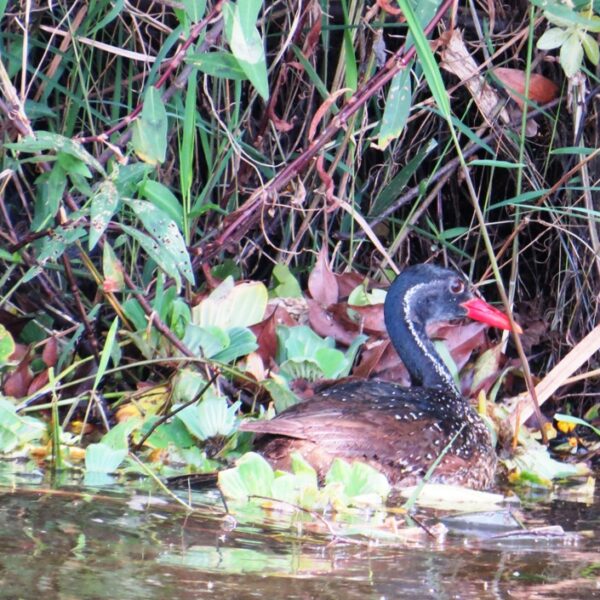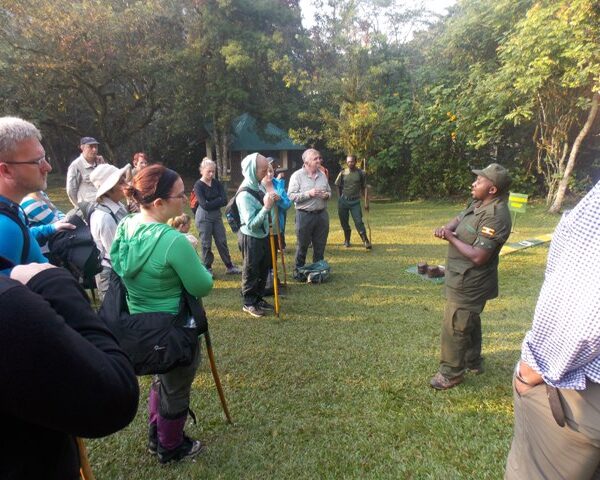Uganda is one of the best destinations for birding safaris in Africa. From the savanna of Lake Mburo and Queen Elizabeth National Parks to the jungles of Semliki National Park,
Uganda is endowed with a breathtaking 24 endemic Albertine Rift bird species, Furthermore having over 1078 bird species in total; it is potentially the best birdwatching destination in Africa
Numerous endemic bird species in the Uganda area are found in Bwindi Impenetrable Forest, Semliki National Park,Kibale Forest, Budongo Forest Rwenzori Mountains, and Mgahinga. These include Green Broadbill, Grauer’s Swamp and Neumann’s Warblers, Shelley’s and Dusky Crimsonwing, Yellow-eyed Black Flycatcher, Strange Weaver, Rwenzori Double-collared, Regal, Purple-breasted and Blue-throated Sunbirds, Rwenzori Turaco, Handsome Francolin, Stripe-breasted Tit, and many others. In the papyrus Mabamba swamp around Lake Victoria and other lakes, the enigmatic Shoebill can be found, as well as specialties including Papyrus Yellow and White-winged Warblers, Carruther’s Cisticola, Papyrus Gonolek, Swamp Flycatcher, and Orange Weaver
Uganda is a landlocked country and lies west of Kenya, east of DR Congo, north of Rwanda and Tanzania, and south of South Sudan. Uganda got its name from the Buganda kingdom, which encompasses a large portion of the south of the country, including the capital Kampala. The populace of Uganda was hunter-gatherers until 1,700 to 2,300 years ago when Bantu-speaking populations moved to the southern parts of the country. Uganda has a population of almost 50 million, ranking it as the 30th largest country in the world in terms of population. With an area of over 93,000 square miles, it is the 81st largest country in the world by area. The capital city of Uganda is Kampala, and it is also the largest city.
Uganda Lakes
Roughly one-quarter of Uganda’s surface area consists of wetlands, ranging from vast inland seas to the mysterious marshy expanse of Lake Kyoga, formed by the Nile as it drains into a shallow sump at the very center of the country. The northwestern third of Lake Victoria, the world’s second-largest freshwater body falls within Uganda’s boundaries, while the extravagantly scenic Lakes Albert and Edward extend for 150 kilometers and 80 kilometers respectively along the Albertine Rift Valley floor bordering the Congo. Renowned for its water birds and dense population of otters, mountain-ringed Lake Bunyonyi is one of Uganda’s most rapidly developing wetland destinations, with its steep-sided shores and small islands dotted with rustic hotels and campsites.
Another rising attraction is the cluster of 200 crater lakes that extends northwards from Queen’s Elizabeth National Park to Fort Portal, reaching its scenic peak in the vicinity of Kibale forest where several forest-fringed lakes have been developed as community-based ecotourism projects such as in Bigodi Swamp
The jewel in Lake Victoria’s crown is the Ssese archipelago whose 84 islands-some large and dotted with local fishing villages, others small and uninhabited-are well watered and lushly forested. Mainlanders traditionally revere Ssese as the Islands of the Gods and one specific island called Bubembe is regarded to be home to Mukasa, the spirit presiding over Lake Victoria. The Ssese Islands make for an ideal retreat after a long safari, and they also offer superb opportunities for bird watching & for hooking heavyweight Nile Perch
Uganda also has 60 protected areas, which include ten national parks, two of which – Bwindi Impenetrable National Park and Rwenzori Mountains National Park – are UNESCO World Heritage Sites. Uganda has over 1000 bird species making it a preferred destination for birding safaris in Africa. These birdwatching destinations in Uganda are home to many endangered species, such as birds, plants, insects, mountain and lowland gorillas, and different kinds of monkeys. In the west, of Uganda, there are a series of mountains associated with the Albertine Rift, the Western Great Rift Valley, the Albertine Rift region spans the borders of the Democratic Republic of Congo, Rwanda, Burundi, Uganda, Tanzania, and extends over a distance of 1,000 kilometers. Albertine Rift is an area of extraordinary endemism and contains many species threatened with global extinction, chiefly within the mountain forest habitats. Over 50 percent of birds, 39 percent of mammals, 19 percent of amphibians, and 14 percent of reptiles and plants found in mainland Africa occur in the Albertine Rift.


